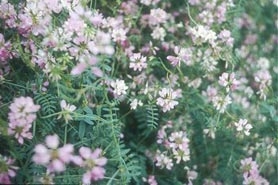Crown vetch
(Coronilla varia)
Herbaceous perennial in the legume family. This species has creeping stems that form dense colonies, growing 2-6' long. Flowers are pinkish to lavender to white and held in clusters. Crown vetch can be recognized as significant brown patches in winter and early spring.
Other names for this plant include:
- Common names: trailing crown-vetch, purple crownvetch
- Scientific names: Securigera varia
Classification in Wisconsin: Restricted
- Ecological Threat
-
- Crown vetch is challenging to control and rapidly reproduces vegetatively via rhizomes that can grow up to 10 feet yearly. One plant may grow to cover 70-100 sq. feet within four years. Its seeds can remain viable in the soil for more than 15 years.
- Crown vetch prefers sunny, open areas but has a broad environmental tolerance. It can grow in full to partial sun, is drought tolerant, withstands heavy precipitation, and colonizes a wide range of soil types.
- It invades various ecosystems including prairies, grasslands, dunes, floodplains, forest edges, gravel bars in waterways, agricultural lands and roadsides.
- Crown vetch alters native ecosystems through nitrogen fixation, enhancing soil fertility.
- It can climb over and smother shrubs and small trees as well as shade-out native herbaceous vegetation.
- The invasion of crown vetch can also change fire behavior by increasing fuel loads.
- Crown vetch has historically been planted for erosion control and is widely distributed throughout the state.
- Identification
-
Leaves: Pinnately compound, alternate, 2-6" long, with 11-25 elliptical leaflets occurring in an odd number. Leaves are hairless.
Flowers: Pea-like, ranging in color from pink or lavender to white. Flowers are clustered in flat-topped umbels of 14-20 flowers that grow on long stalks extending from the leaf axils. Bloom from mid-spring through August.
Fruits & seeds: Long, slender, pointed seed pods contain 3-7 little seeds each. Seeds remain viable in the soil for up to 15 years.
Roots: Reproduces vegetatively by fleshy rhizomes that grow up to 10' long. Roots are not fibrous, limiting the utility of crown vetch for erosion control.
Similar Species: Crown vetch can be distinguished from other plants in the legume family by its compound leaves with an odd number of leaflets. Also, its leaves and flower stalks arise from the main stem and the species has flat-topped umbels.
- Control
- Mechanical:
- For more minor infestations, repeated hand-pulling can be effective. Make sure to pull up the whole plant (including the roots).
- Cover patches with black landscape plastic or fabric for a minimum of one entire growing season.
- Mow in late spring for several consecutive years. Populations can also be mowed twice yearly, once in June and once in late August, correlated with leaf-out. This will need to be repeated for multiple years.
- Controlled burning in late spring can be effective but may need to be repeated for several years for adequate control. Burning may stimulate seed germination.
Be sure to follow all label rates when applying herbicides.
- Foliar spray clopyralid, metsulfuron, or aminopyralid ensuring all leaves are wet but not dripping. The previous year's growth should be removed to ensure herbicide contact with actively growing plants to provide good foliar coverage. Spot application should be made with a hand sprayer and uniform so the entire leaf is wetted, not dripping. All herbicides are most effective when applied in early spring, before flowering, when the plant is actively growing.
- Clopyralid is a more selective herbicide and is more effective than other herbicides.
- 2,4-D amine or a solution of 2% active ingredient triclopyr are both broadleaf specific.
- A 1 or 2% active ingredient solution of glyphosate can also be used, but this is a non-specific herbicide.
For more information on control techniques, visit the Crown vetch factsheet [exit DNR] by the University of Wisconsin-Extension.
- Resources
- Sources for content:
- Czarapata, Elizabeth; Invasive Plants of the Upper Midwest: an illustrated guide to their identification and control. The University of Wisconsin Press. 2005. Pg. 57-58
- University of Wisconsin-Extension, Weed Science
- USDA Plants Profile


